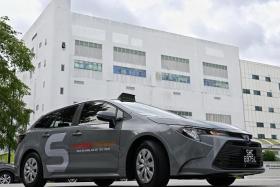App aims to direct cabbies to spots with high street-hail demand
A taxi guidance system that is being co-developed by a laboratory in the Singapore Management University (SMU) could well be the solution to help cabbies hold their own as they battle it out with private-hire car drivers.
The average daily ridership for taxis has dropped by 18 per cent, from 954,000 in 2016 to 785,000 last year. The taxi population has also declined by 14 per cent, from 27,534 in 2016 to 23,140 last year.
The Fujitsu-SMU Urban Computing and Engineering Corporate Lab - a collaboration among SMU, Japanese technology firm Fujitsu and the Agency for Science, Technology and Research - is looking into an app that aims to direct cabbies to areas of high street-hail demand.
The system uses historical data as well as real-time data from the Land Transport Authority on taxi locations and status to predict demand.
For example, if a number of taxis change their status from available to hired along a certain stretch of road, this would indicate high demand in that area.
"This gives us a pretty good idea of the demand and supply of taxis in a certain area," said Associate Professor Cheng Shih-Fen, deputy director of research at the laboratory, which studies congestion and its solutions as one of its key areas of research.
The app has produced "positive results" for the more than 400 cabbies who have installed it since November, when it was introduced at a National Taxi Association (NTA) event.
The NTA earlier this month called for taxis to be equipped with technology to allow cabbies to "drive smarter and safer".
The app has made a significant difference during off-peak hours, when demand is more sporadic and harder to predict, said Prof Cheng, who added that he hopes to have more than 1,000 cabbies using it in the future.
For example, cabbies using the app between midnight and 6am on weekdays in the Central Business District had an empty cruising time of about 12 minutes. In comparison, drivers who did not use the app experienced more than 17 minutes of empty cruising.
Get The New Paper on your phone with the free TNP app. Download from the Apple App Store or Google Play Store now



